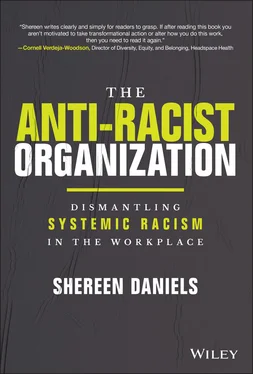This sudden pressure to act caught many unawares. In their bid to do something, many took knee‐jerk and fragmented actions, sometimes simply rehashing old approaches to diversity and inclusion and relabelling them as anti‐racism.
Because who were you if you weren't anti‐racist?
Racial equity as a term came later. When there was a concern the word racism was too divisive.
However, the general public and colleagues wised up and began to scrutinise who was doing what and what was their quantifying impact.
Statements, hashtags, clever social media posts were no longer cutting it. Companies had to do something, so where did the majority start?
We are revamping our policies and reaching out to our Black colleagues. They are in so much pain and it breaks my heart .
HR manager, 2020
The most typical response to addressing racism is found in the belief that policies, procedures and HR technology (bizarrely) are the holy grail of where racism lives and dies. It's the default action when it becomes apparent that there is an issue with how certain groups are treated, and it becomes the go‐to item on the job description for new diversity, equity and inclusion hires.
Not enough Black candidates? Buy a tech solution that promises to eliminate bias. Lack of representation at board level? Brief the executive search company to ‘get more, and fast’. Complaints about racial discrimination and harassment? Update your policy and emphasise that you take a zero‐tolerance approach to racism. Even better, run a survey and ask colleagues how many times they’ve witnessed racism.
These are the default actions when it becomes apparent there are issues with how certain groups are treated, and they become the go‐to items on the job description for new diversity, equity and inclusion hires.
That is absolutely part of what you may need to look at it, but it isn't the whole picture. These approaches lack context, depth and nuance, and offer little to no evaluation of root causes.
There is likely a recognition that your processes, policies, systems – the informal and formal ways of doing things – may not be as inclusive as they should be. But there may also be a recognition that your company perpetuates racism. Not because you hire bad people or because you've deliberately set out to oppress certain groups. But if you don't confront the roots of what excludes people due to their ethnicity, if you fail to challenge your own preconceptions of what racism is and what it isn't, and if you use your discomfort as a convenient barrier to block change, this is exactly how we've gotten here today. In what's meant to be the most technologically advanced period known to humankind, our apathy, discomfort and fear allow the system called racism – because that's what it is, a system – to continue doing its best work. It is a system that perpetuates consistent favourable outcomes for some and consistent unfavourable outcomes for others, a system that isn't confined just to the US, despite what we believe in the UK; neither is it a nonissue in predominantly Black or Brown countries.
Ignorance is bliss when racism doesn't impact you. But in a post‐2020 world, ignorance isn't so blissful when you are expected to disclose why you have taken little to no meaningful action to diversify your business, and to take the necessary steps to root out discrimination and inequity and address the issues in a sustainable way.
Forget the panic and emotion we see orchestrated by the media. Think about the questions you are being asked at board meetings, town halls, earnings calls. The information you are expected to share in your annual reports, disclosures and the like. It's changed, hasn't it? It will continue to change. One could predict that there will be even more support for shareholder proposals that specifically address climate and social issues, and rather than being separate, governance is woven in.
There is already a much greater weight put on how your business operations impact the welfare of all your stakeholders, not just the ones you deem ‘valuable’. There is a disruption to the notion of assigning value to what works for the majority. Even the idea that you can't please everyone is geared towards majority rules.
Who are the majority within your organization? Where do they sit within your hierarchy? How much influence do they have? Are they the ones who influence your decisions about not only what you do, but the depths, the commitment and the speed of action?
Is their discomfort central to your decision‐making?
In their 2021 report ‘The Economic State of Black America’, consulting firm McKinsey & Company identified that it would take 95 years for Black workers to reach talent parity with their white counterparts. Their research analysed overall employment data from 24 companies, including some of the largest private‐sector employers in the United States, who participated in this research across a total of about 3.7 million US employees. Some other key statistics include:
Black employees are underrepresented in the highest‐growth geographies and the highest‐paid industries.
Black employees are overrepresented in low‐growth geographies and in frontline jobs, which tend to pay less.
In the private sector, 45% of Black employees (6.7 million people) work in three industries that have a large frontline‐service presence: healthcare, retail and accommodation and food service.
Black employees are underrepresented in IT, professional services and financial services.
Black private‐sector workers, 43%, make less than $30,000 per year, compared with 29% of the rest of private‐sector employees.
Black workers believe their organizations are less fair, accepting and authentic.
Black workers face greater hurdles to gainful employment than do the rest of the labor force, creating stark disparities. For example, the employment rates for Black workers with some college or an associate's degree are similar to the total population of workers who have a high school diploma.
McKinsey & Company, 2021
Between October and December 2020 in the UK, the unemployment rate rose from 24.5% to 41.6% for Black people aged 16–24, three times more than white workers of the same age, where it rose from 10.1% to 12.4% (Office for National Statistics, 2021).
In August 2021, the US Bureau of Labor Statistics disclosed that the Black unemployment rate went up from 8.2% to 8.8%. In comparison, the white unemployment rate dropped by 0.3% to 4.5%; the Asian unemployment rate dropped 0.7% to 4.6%; and the unemployment rate for Hispanic and Latino workers fell 0.2% to 6.4%. Black unemployment is almost 50% higher than white unemployment levels (US Bureau of Labor Statistics, 2021).
The Start of Uncomfortable Questions
How do you establish impactful programmes that not only dismantle systemic racism but also set a strong foundation for a sustainable business that sees the social and governance aspects of ESG frameworks and stakeholder capitalism as an opportunity to do more and to do better, not to get away with doing the bare minimum through force and compliance? And here are some more things to consider:
How do you ease the friction between competing stakeholder interests?
What is the impact on the decisions you make about allocating capital and resources?
How do you think about risk (political, public perception, colleague expectation and changes to customer attitudes)?
How confident are you in the leadership capability of your teams to play their part in dismantling systemic racism? Or is there a nagging thought that they might be part of the problem?
Managing talent is probably one of the top priorities for executive boards around the globe. How do you motivate, inspire and unleash the potential of colleagues who are essential for where you are headed? Colleagues who get your mission, whose behaviour aligns with your values and who already have put their hat in the ring to help transform your culture for the benefit of everyone?
Читать дальше












